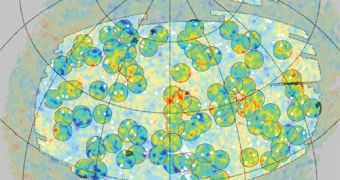Approximately a decade ago astronomers discovered that not only is the universe expanding in space-time, but also that this expansion is accelerating. Since there was no explanation to why this is happening, they proposed the concept of dark energy, a form of energy that makes up about 75 percent of the mass of the universe, was never directly observed and exerts a force of repulsion towards all normal matter in the universe, causing the latter to expand.
Nevertheless, ten years later researchers are still trying to understand what dark energy actually is, or whether it really exists and is not just the product of our imagination. Others suggested that in fact the expansion of the universe is not accelerating at all, but that a similar effect could be produced by uneven matter distribution across the universe, which would distort our observations, making distant supernovae appear as though they are farther away than they really are.
So in order to establish once an for all whether or not dark energy exists, Istvan Szapudi from the University of Hawaii along with his colleagues turned to the remnant radiation from the Big Bang, the Cosmic Microwave Background, which is able to reveal matter distribution in the early days of the universe.
If dark energy indeed exists, then it should show up on the Cosmic Microwave Background map as supplemental temperature variations, created by microwave photons as they pass through regions of the universe with different matter densities. When a photon of light passes through a region with high densities of matter, it is lightly accelerated by the gravitational field of the respective area, thus increasing its energy.
The reverse effect takes place when the photon moves away from the respective area, losing energy as it tries to escape from the gravitational well.
If no dark matter in the universe were present, then the energy variation of the photon would be null before and after it passes through a gravitational well. Albeit, if dark energy was taken into consideration, the universe would expand fast enough to stretch the gravitational well as the photon is still crossing it, enabling the photon to escape easier from it and without losing all of the gained energy.
Therefore, a photon passing through a galaxy cluster for example, would have more energy after it exits it than before it entered. This would show up on the CMB as a hot spot. The problem is that these energy variations produce similar effects as normal temperature variation in the CMB map.
To counter this effect, Szapudi said, the team chose to make observations in regions of space with extreme density variations, since those would be the areas with the highest temperature variations. Indeed, observations in regions of space containing some 3,000 galaxy superclusters and 500 voids revealed increasingly hot and cold spots in the CMB. Furthermore, the team demonstrated that the effect had a chance of 1 in 200,000 of being determined by anything other than dark energy.
"We have shown the imprint on the CMB of dark energy at work. In this sense, we have imaged dark energy. We've really attacked the dark energy question in a different way from supernovae measurements. It's difficult to argue that an illusion could be responsible for this effect", says Szapudi.
"People have discussed this effect, but this is the first really clear-cut signal", said Thomas Buchert from the University of Lyon, one of the skeptics doubting the existence of dark energy. Buchert also said that the same effect may be obtained through a warping of space-time around such structures, a possibility which is not taken into consideration in current standard calculations.
Buchert further points out that the temperature variations are much higher than previously expected, which may be a sign that dark energy is not responsible for the effect.

 14 DAY TRIAL //
14 DAY TRIAL //